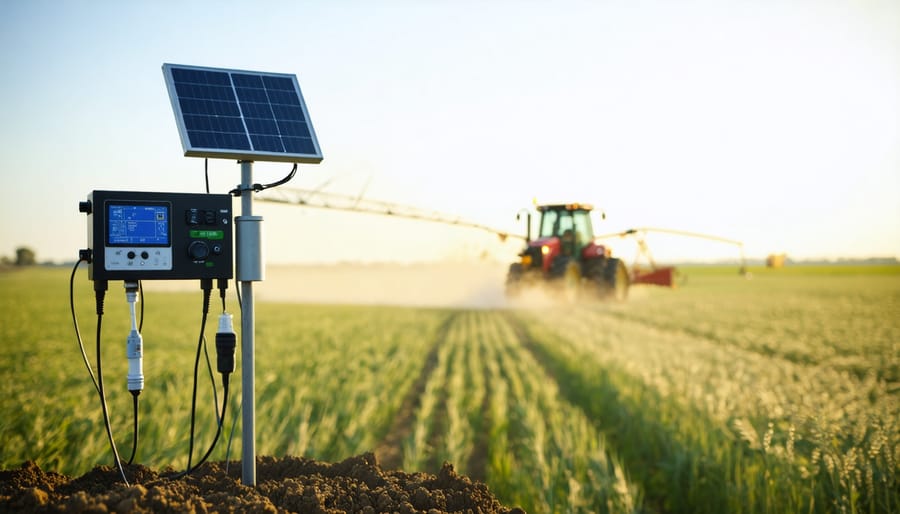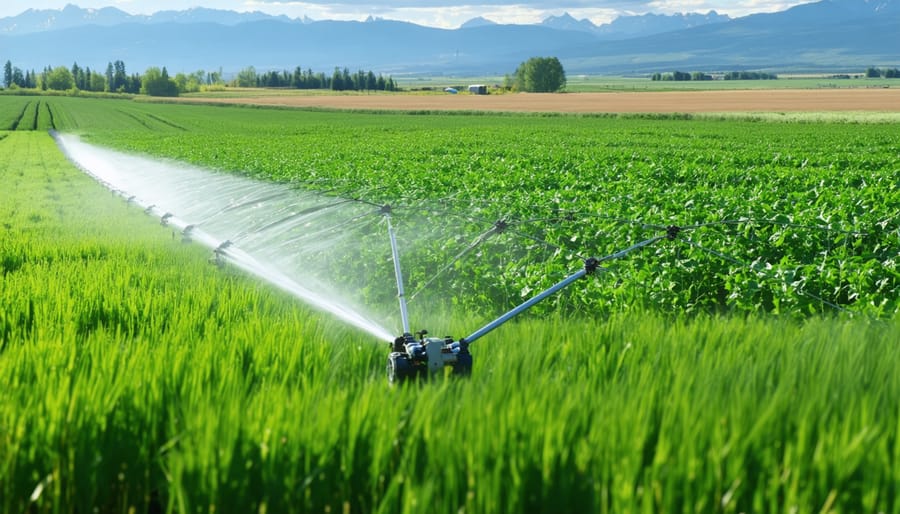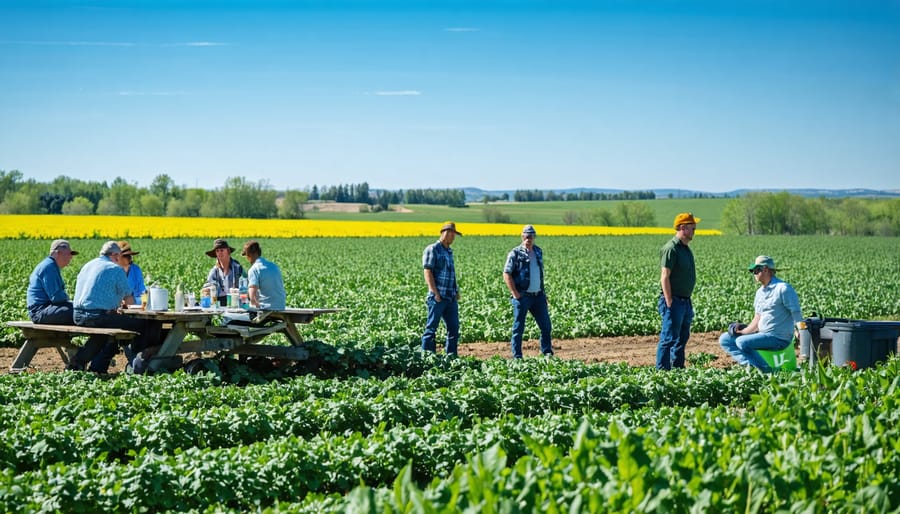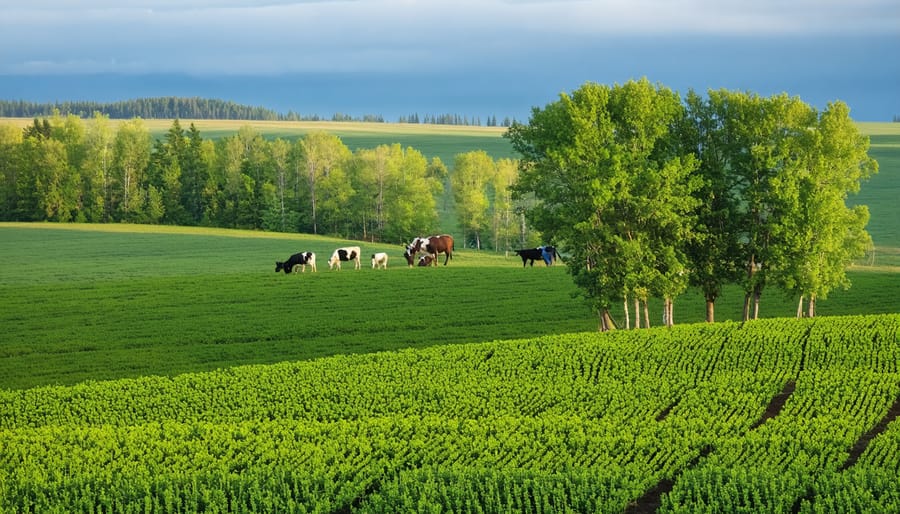The Journal of Agricultural Water Management stands as the world’s leading peer-reviewed publication connecting cutting-edge water research with real-world farming solutions. For Canadian producers facing increasingly unpredictable precipitation patterns and growing pressure to maximize every drop, this journal bridges the gap between university research and your field operations.
Published since 1976, this international resource delivers practical insights on irrigation efficiency, soil moisture optimization, drainage management, and water conservation strategies tested across diverse climates and crops. Each issue translates complex hydrological studies into actionable techniques that Alberta farmers can adapt to their unique conditions—from the dry southern prairies to the parkland regions.
What sets this journal apart is its focus on economic viability alongside environmental stewardship. Research published here doesn’t just explore theoretical possibilities; it examines cost-benefit analyses, yield impacts, and implementation feasibility that directly affect your bottom line. Recent studies have demonstrated how smart water management practices can reduce water use by 20-40% while maintaining or even increasing crop productivity.
Whether you’re considering precision irrigation upgrades, exploring drought-resistant cropping systems, or seeking evidence-based solutions for water allocation challenges, this journal provides the scientific foundation to make confident decisions. The following sections explore how Canadian producers are already implementing these research findings to build more resilient, profitable operations while safeguarding water resources for future generations.
What the Journal of Agricultural Water Management Teaches Us
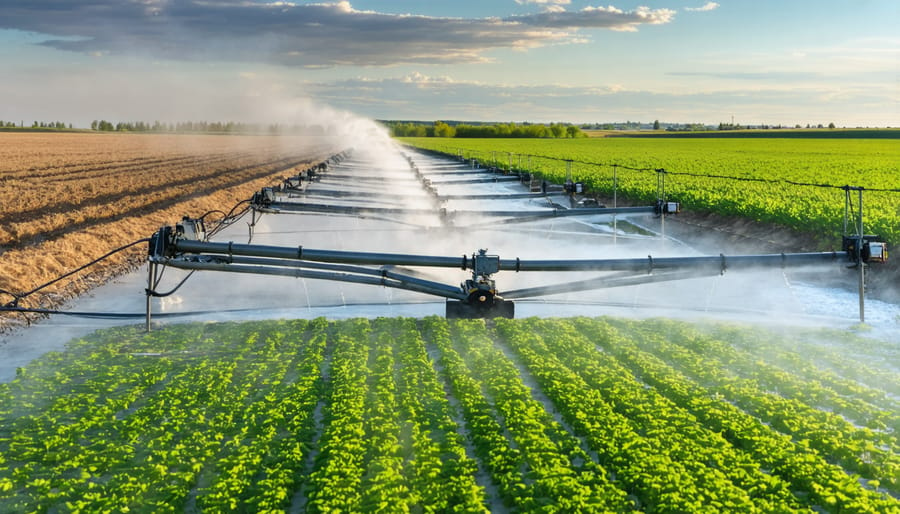
Research That Translates to Your Fields
The Journal of Agricultural Water Management regularly publishes research that directly addresses challenges you’re facing on Canadian prairie farms. Recent studies have examined irrigation scheduling techniques that reduced water use by 25-30% while maintaining crop yields in semi-arid conditions similar to southern Alberta. These findings translate into real dollar savings and improved water conservation on your operation.
Drought management research featured in the journal has explored deficit irrigation strategies specifically for wheat and canola—two cornerstone crops in our region. One particularly relevant study tested moisture sensor technology combined with variable rate irrigation, demonstrating how farmers could optimize water application during critical growth stages while minimizing waste during periods when crops are less sensitive to water stress.
The journal also covers essential water-soil interaction research that helps you understand how different soil types across the prairies—from heavy clay to sandy loam—affect water retention and movement. This knowledge is crucial when planning irrigation infrastructure or adjusting watering schedules based on your specific field conditions.
Studies on groundwater sustainability have examined aquifer recharge rates in prairie regions, providing data that helps agricultural professionals make informed decisions about long-term water resource planning. Research on water quality impacts from agricultural runoff has also led to practical management strategies that protect both your water sources and downstream ecosystems, ensuring sustainable farming practices for future generations.
From Lab Results to Farm Success
Research published in the Journal of Agricultural Water Management doesn’t need to feel overwhelming. Most articles include practical summaries that translate complex data into actionable insights you can use on your farm.
Start by focusing on the abstract and conclusion sections—these highlight key findings without diving into heavy statistics. Look for research conducted in similar climates or soil types to yours. Studies from the Canadian Prairies or regions with comparable growing seasons offer the most relevant guidance for Alberta operations.
Pay attention to the “materials and methods” section, which often describes specific irrigation schedules, equipment settings, or soil moisture targets. These details provide concrete starting points you can adapt to your fields. Many articles also include graphs showing water application rates versus crop yields—visual tools that make comparisons straightforward.
Don’t hesitate to reach out to your local agricultural extension office or irrigation specialists. They can help interpret findings and suggest modifications suited to your specific operation. Some farmers find success by testing research recommendations on small trial plots before farm-wide implementation.
Remember, even incremental changes based on scientific findings can lead to measurable improvements in water efficiency and crop production over time.
Water Management Challenges Facing Alberta Agriculture
The Prairie Water Paradox
Alberta’s prairie landscape presents a unique water management puzzle that keeps farmers on their toes. Unlike regions with predictable rainfall, our province experiences dramatic swings—from drought conditions that crack the soil to sudden downpours that can overwhelm drainage systems. This variability makes planning irrigation schedules and crop selection feel like reading tea leaves.
Research published in the Journal of Agricultural Water Management has become invaluable for understanding these patterns. Scientists are using decades of precipitation data combined with soil moisture monitoring to develop predictive models specifically for prairie conditions. These studies help identify which areas are most vulnerable to water scarcity and when intervention becomes critical.
Dr. Sarah Chen, a water management researcher at the University of Alberta, explains it this way: “We’re not just tracking rainfall anymore. We’re examining how different soil types across Alberta retain moisture, how crop varieties respond to stress, and what this means for your bottom line during dry spells.”
The practical application is straightforward. Research findings translate into region-specific irrigation timing recommendations, helping you decide whether to invest in water conservation infrastructure or adjust your crop rotation. Recent studies have shown that combining deficit irrigation strategies with drought-resistant crop varieties can maintain yields while reducing water use by up to 30 percent—a significant advantage when every drop counts during those inevitable dry years that define prairie farming.
Climate Change Impact on Water Availability
Alberta farmers are experiencing firsthand how climate change is reshaping water availability across the Prairies. Research published in agricultural water management journals reveals three critical shifts affecting our region: changing precipitation patterns, earlier spring snowmelt, and extended growing seasons that alter traditional water planning.
Precipitation is becoming less predictable, with some areas receiving intense rainfall events while others face prolonged dry spells. A 2022 study tracking Alberta watersheds found that spring snowmelt now occurs 10-14 days earlier than it did three decades ago, significantly impacting reservoir timing and irrigation schedules. This earlier melt, combined with growing seasons extending by approximately 12 days since 1990, means crops require water during different timeframes than historical planning anticipated.
These shifts present both challenges and opportunities. While earlier snowmelt can strain late-season water supplies, longer growing seasons may allow for crop diversification. Dr. Sarah Chen from the University of Alberta notes, “Farmers who monitor these patterns and adjust their water management accordingly are better positioned to maintain yields.” Understanding these evidence-based trends is essential for developing effective climate change adaptation strategies that protect both productivity and water resources for future generations.
Educational Resources from Water Management Research
Finding Research You Can Actually Use
Accessing valuable research from the Journal of Agricultural Water Management doesn’t require a university affiliation. Start by visiting the journal’s website and filtering for open-access articles—these are free to read and often include the most recent studies. Look for the green “Open Access” badge next to article titles.
When browsing, focus on the abstract first. This 200-word summary tells you whether the study applies to your situation. Pay attention to crop types, climate conditions, and soil characteristics mentioned. If researchers tested drip irrigation on canola in semi-arid conditions, that’s directly relevant to many Alberta operations.
The “Highlights” section at the beginning of each article provides bullet-point takeaways—perfect for busy farmers who need quick insights. These typically outline the practical outcomes, such as “reduced water use by 30% while maintaining yield” or “optimal irrigation scheduling for drought conditions.”
To find region-specific research, use the journal’s search function with terms like “semi-arid,” “short growing season,” or your specific crop name. Canadian studies appear regularly, and researchers often include detailed methodology you can adapt to your own fields.
Many articles include tables comparing different irrigation strategies with measurable results—water volume applied, yield per hectare, and cost analyses. These data points help you evaluate whether implementing a particular technique makes economic sense for your operation. Don’t hesitate to contact study authors directly; researchers appreciate hearing from farmers applying their work.
Canadian Water Management Programs and Training
Canadian farmers have access to robust water management support through various provincial and federal initiatives that bridge academic research with on-farm application. Agriculture and Agri-Food Canada (AAFC) offers practical resources through their regional development centers, helping producers implement evidence-based irrigation strategies and water conservation techniques drawn from peer-reviewed studies.
Alberta Agriculture and Irrigation operates several agricultural education programs specifically addressing water stewardship in the prairies. Their Irrigation Management Workshops translate complex research findings into actionable steps for optimizing water use efficiency, particularly valuable given Alberta’s semi-arid growing conditions.
The University of Alberta and University of Calgary provide extension services that connect farmers directly with researchers studying agricultural water management. These programs often feature field days where producers can see research applications firsthand and discuss challenges with experts who understand local conditions.
“We’ve seen tremendous uptake when farmers can connect journal research to their specific soil types and crops,” shares Dr. Patricia Henderson, an extension specialist who works with southern Alberta producers. “Making that research accessible and relevant is key to adoption.”
National programs like the Canadian Agricultural Partnership also fund on-farm water management projects, allowing producers to test innovative irrigation technologies and soil moisture monitoring systems backed by scientific evidence. These initiatives ensure that cutting-edge water research reaches the field level, supporting both productivity and environmental sustainability across Canadian agriculture.
Sustainable Irrigation Techniques Backed by Science
Precision Irrigation Technologies
Research published in the Journal of Agricultural Water Management consistently demonstrates that precision irrigation technologies can reduce water usage by 20-40% while maintaining or improving crop yields. For Canadian farmers, particularly those facing Alberta’s variable precipitation patterns, these tools offer practical solutions backed by rigorous field trials.
Soil moisture sensors represent the foundation of precision irrigation. Studies validate that capacitance-based sensors, when placed at multiple depths (typically 15, 30, and 60 centimeters), provide accurate real-time data to guide irrigation decisions. Research shows farmers using sensor networks reduce over-irrigation events by up to 35%.
Weather-based scheduling systems integrate local meteorological data with crop evapotranspiration rates. A 2022 study tracking 47 Alberta farms found that weather-responsive controllers cut water consumption by 28% compared to traditional timer-based systems, with payback periods averaging 2.3 growing seasons.
Variable rate irrigation (VRI) technology allows zone-specific water application across fields. Journal research confirms VRI systems optimize water distribution in fields with varying soil types or topography—common across prairie landscapes.
**Cost-benefit considerations vary by operation size:** Small farms (under 65 hectares) often benefit most from basic soil moisture monitoring systems ($1,500-$3,000 investment). Mid-sized operations (65-260 hectares) see strong returns with weather-based controllers ($5,000-$8,000). Larger farms (260+ hectares) can justify VRI systems ($15,000-$40,000) through water savings and yield improvements documented across multiple peer-reviewed studies.
Deficit Irrigation Strategies
Deficit irrigation strategies involve carefully applying less water than a crop’s full requirement at specific growth stages, encouraging plants to develop deeper root systems and use water more efficiently. Research featured in the Journal of Agricultural Water Management demonstrates that controlled water stress during non-critical growth periods can maintain 85-95% of potential yields while reducing water use by 20-40%.
In Southern Alberta, canola producers have successfully implemented regulated deficit irrigation (RDI) during the vegetative stage, reserving full irrigation for flowering and pod development. This approach has proven particularly effective during drought years, allowing farmers to stretch limited water allocations across more acres without sacrificing overall production quality.
Prairie potato growers are adopting similar techniques, applying mild stress during tuber bulking while maintaining adequate moisture during emergence and flowering. These controlled approaches require careful soil moisture monitoring using tensiometers or soil probes, typically checking levels every 2-3 days during critical periods.
The key to success lies in understanding your crop’s specific water sensitivity windows. Start conservatively with 10-15% reductions during low-stress periods, keeping detailed records of soil moisture, crop response, and final yields. Many Alberta producers report that deficit irrigation not only conserves water but can also improve crop quality markers like sugar content in some crops.
Water Recycling and Reuse Systems
Research published in the Journal of Agricultural Water Management highlights innovative approaches Canadian farmers can adopt to maximize water efficiency. Tailwater recovery systems capture runoff from irrigated fields and return it for reuse, reducing freshwater demands by up to 30%. Alberta producers like the Lethbridge Northern Irrigation District have successfully implemented these systems, demonstrating significant cost savings during drought periods.
Constructed wetlands offer a natural solution for treating agricultural runoff before it re-enters irrigation systems. These engineered ecosystems remove excess nutrients and sediments while providing wildlife habitat. Studies featured in the journal show that properly designed wetlands can treat water to irrigation-quality standards within 48-72 hours.
Closed-loop irrigation systems represent the frontier of water conservation, recirculating water within greenhouses and controlled environments. Research from Ontario greenhouse operations indicates these systems reduce water consumption by 90% compared to traditional methods. While initial investment costs range from $15,000-$50,000 per hectare, payback periods average 3-5 years through reduced water purchases and improved crop consistency.
Soil Health and Water Retention Connections
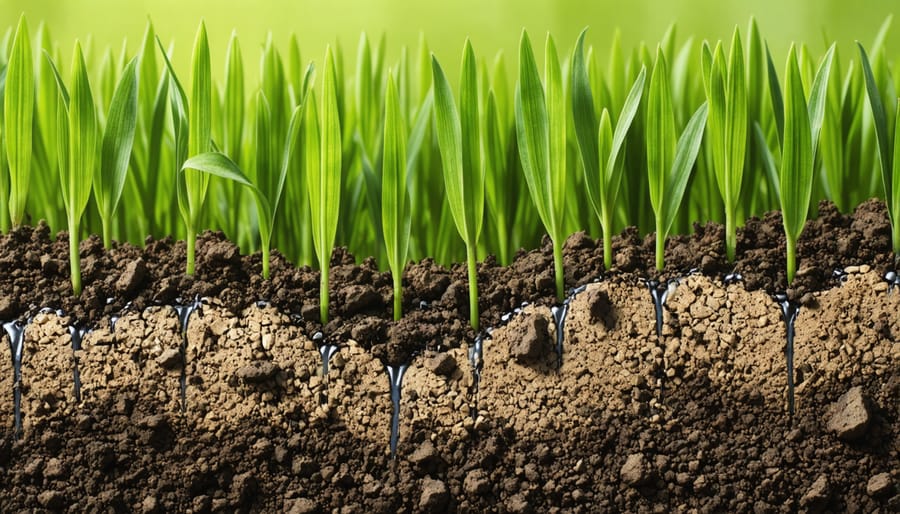
Cover Crops and Water Conservation
Research published in the Journal of Agricultural Water Management demonstrates that strategic cover cropping can reduce soil water evaporation by up to 50% while improving moisture retention throughout the growing season. This practice creates a protective layer that shields soil from wind and sun exposure—particularly valuable during Alberta’s dry springs and hot summers.
For Alberta conditions, fall rye stands out as an exceptional choice, establishing quickly before winter and providing early spring coverage. Winter wheat offers similar benefits with the added advantage of cold hardiness. Hairy vetch, though requiring careful management, fixes nitrogen while conserving moisture—a dual benefit for your soil health investment.
A 2022 study featured in the journal showed that farms incorporating diverse cover crop mixes maintained 15-20% higher soil moisture levels during drought periods compared to bare soil management. This translated to improved cash crop establishment and reduced irrigation needs.
Local agronomist Sarah Chen from Lethbridge explains, “The key is matching cover species to your rotation and termination timing. Start small with one field to understand how covers perform in your microclimate before expanding.”
Consider blending species like oats with legumes for maximum water conservation and soil improvement benefits during your transition to this practice.
No-Till and Reduced Tillage Benefits
Long-term research from Agriculture and Agri-Food Canada demonstrates that no-till and reduced tillage practices can increase soil water storage by 15-25% compared to conventional tillage methods. Studies conducted across the prairies, including extensive trials at Lethbridge Research and Development Centre, show that undisturbed soil maintains better structure and porosity, allowing moisture to infiltrate deeper rather than running off the surface.
Conservation tillage creates a protective layer of crop residue that acts as a natural mulch, reducing evaporation rates by up to 30% during Alberta’s hot, dry summers. This residue cover also moderates soil temperature, keeping moisture available to crops for longer periods throughout the growing season.
Data collected over 20-year periods in southern Alberta reveals that fields under continuous no-till management retain approximately 25-50 millimetres more plant-available water in the root zone compared to conventionally tilled fields. This moisture advantage translates directly to improved crop resilience during drought years—a critical benefit as climate variability increases.
Manitoba farmer Dale Cowan, who transitioned to no-till operations fifteen years ago, reports that his fields now withstand dry spells that would have devastated crops under his previous tillage system, allowing him to maintain more consistent yields while reducing fuel and labour costs.
Real Alberta Farmers Making Research Work
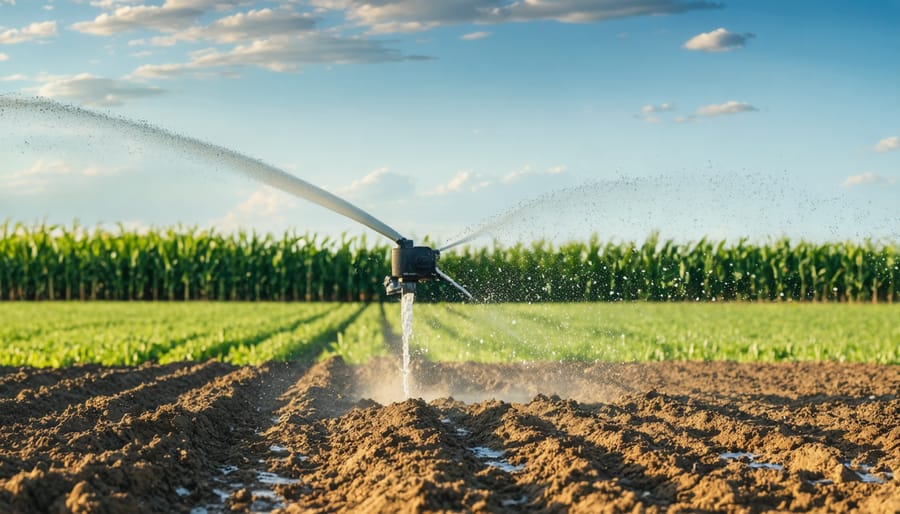
Southern Alberta Irrigation Innovation
When Tom Hendricks first learned about precision irrigation through research published in agricultural water management journals, he was skeptical. “I thought our flood irrigation system was working just fine,” says the third-generation farmer from Lethbridge, who grows barley and canola on 800 hectares.
After attending a workshop in 2021 hosted by Alberta Agriculture, Tom decided to pilot precision irrigation on 200 hectares. Working with local agronomists, he installed soil moisture sensors at various depths and switched to variable rate irrigation. He also implemented conservation tillage practices to improve soil water retention.
The results surprised even Tom. “We cut water use by 30% in the first season while matching our previous yields,” he explains. By monitoring soil moisture in real-time through a smartphone app, Tom now irrigates only when crops need it, avoiding the guesswork that led to overwatering.
His approach combines findings from academic research with practical Alberta conditions. Tom tracks precipitation patterns, adjusts irrigation schedules based on growth stages, and maintains organic matter levels above 3% to maximize water retention.
“The science backs up what we’re seeing in the field,” Tom notes. “When you give crops exactly what they need, they respond.”
Dryland Farming Water Wisdom
In the heart of southern Alberta’s Palliser Triangle, the Henrikson family transformed their 1,200-hectare dryland operation by implementing moisture conservation strategies published in agricultural water management research. Facing increasingly unpredictable precipitation patterns, they adopted a combination of techniques that significantly improved their crop reliability.
“We started with stubble management and moved to no-till practices based on research showing 15-20% better moisture retention,” explains third-generation farmer Daniel Henrikson. “The difference during our 2021 drought was remarkable—our yields held at 80% of normal while neighbours using conventional tillage dropped to 50%.”
The operation now uses precision seeding to place crops at optimal depths for moisture access, typically 5-8 centimetres depending on soil conditions. They’ve also incorporated cover crops in their rotation, which research shows can reduce evaporation by up to 30% while improving soil structure.
Dr. Maria Chen, soil scientist at the University of Alberta, notes that the Henriksons’ approach mirrors findings from controlled studies. “They’re living proof that academic research translates to real-world success. Their soil now holds 25 millimetres more available water than before implementation—that’s the difference between a failed crop and a viable harvest in dry years.”
Building Your Water Management Knowledge Base
Continuing your water management education doesn’t have to feel overwhelming. Start by connecting with Alberta Agriculture and Irrigation, which offers free workshops and consultation services specifically tailored to our province’s unique climate challenges. Their regional offices provide hands-on guidance that complements research from the Journal of Agricultural Water Management with local expertise.
Join community learning groups like the Alberta Irrigation Projects Association or your local Agricultural Service Board chapter. These organizations host field days where you can see water-efficient systems in action on neighbouring farms. Many Alberta farmers find these peer-to-peer learning opportunities invaluable for understanding how academic research translates to real-world conditions on similar operations.
Consider subscribing to the Canadian Water Resources Journal alongside international publications. This keeps you informed about both global innovations and Canada-specific research. Your local library or agricultural extension office may provide free access to these journals, making the latest research more accessible than you might expect.
Build relationships with irrigation specialists and agronomists in your area. The University of Alberta’s Department of Agricultural, Food and Nutritional Science offers extension programs and maintains a network of experts willing to discuss water management strategies. Similarly, Olds College’s Smart Farm initiative provides practical demonstrations of precision irrigation technology.
Set aside time quarterly to review new case studies and research findings relevant to your crops and soil types. Create a simple filing system—digital or physical—to organize articles, workshop notes, and contact information. This personalized knowledge base becomes increasingly valuable as you refine your water management practices over successive growing seasons.
Remember, building expertise is a journey shared by your entire farming community. Your questions and experiences contribute to collective learning that strengthens agricultural resilience across Alberta.
Research-informed water management isn’t just good science—it’s a practical investment in your farm’s future. The insights published in journals like the Journal of Agricultural Water Management offer proven strategies that Alberta farmers are already using to reduce costs, improve yields, and build resilience against our increasingly unpredictable climate.
You don’t need to overhaul your entire operation overnight. Start with one manageable change: perhaps installing a basic soil moisture monitor in your highest-value field, or adjusting your irrigation schedule based on evapotranspiration data. Track your results over a season. Many farmers find that small, evidence-based adjustments deliver surprising returns in both water savings and crop performance.
Remember, you’re not alone in this journey. Connect with your local agricultural extension office, join producer groups, and share what you learn with neighbours. The strongest farming communities are built on shared knowledge and mutual support. Every small step toward smarter water management strengthens not just your operation, but the long-term sustainability of agriculture across the Prairies. Your willingness to adapt today creates opportunity for the next generation of Canadian farmers tomorrow.

